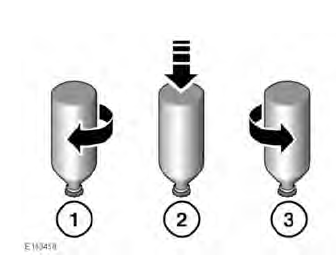Land Rover Discovery: Diesel exhaust fluid (DEF)
In order to comply with exhaust emissions requirements, some vehicles with diesel engines are fitted with a reservoir containing Diesel Exhaust Fluid (DEF). In some markets, DEF is known as AdBlue, AUS 32 and ARLA 32.
Note: It is a legal requirement that the DEF system is used correctly, as detailed in this handbook. It may be a criminal offence to run the vehicle when it is not consuming the correct specification of DEF.
DEF consumption can vary greatly dependent on driving style and conditions, but the average rate of consumption is approximately 1 litre for every 1 600 kilometres.
The distance until the next DEF refill, can be viewed in the Message centre via the Instrument panel menus.
Note: When the DEF level becomes low, an appropriate message will be displayed in the Message centre. It is recommended to contact a Retailer/Authorised Repairer to arrange a DEF refill, at the earliest opportunity.
The Message centre will display a distance countdown, when the DEF level becomes too low. The DEF should be topped up before the distance range falls to zero.
Failure to do so, will result in the vehicle failing to start.
DEF can be added to the reservoir by using the top up procedure; however, a full system refill is still recommended at the earliest opportunity.
Two standard sized non-drip refill bottles, each containing 1.89 litres of fluid, is the minimum amount required to restart the engine. Refill bottles are available from a Retailer/Authorised Repairer.
- When refilling, make sure that the
correct specification of DEF is used. Use of incorrect fluid could
result in serious damage to the
vehicle. Do not start the engine.
Contact a Retailer/Authorised Repairer immediately.
- Do not use DEF dispensing nozzles
as used for commercial vehicles.
The system is not designed to be filled under the pressure and flow-rate that such pumps dispense at, therefore, damage could occur.
- DEF can smell unpleasant and stain clothing or upholstery. Take care not to spill the fluid when performing a top up procedure. In the event of spillage, rinse immediately with clean water.
Read the label for safety precautions, when using DEF.
DEF must be kept out of the reach of children.
DEF must be stored in the original container, in a cool, dry and well-ventilated area. Observe the manufacturer's storage and handling recommendations.
To perform a DEF top up procedure: Locate the DEF reservoir. Remove the reservoir filler cap by turning counterclockwise.

- Place the refill bottle over the reservoir filler cap aperture and turn clockwise, until it is locked into position.
- Press the base of the refill bottle, until all of the fluid has completely drained into the reservoir.
- Turn the refill bottle counter-clockwise and remove.
- Repeat the procedure with the second refill bottle.
- Replace the reservoir filler cap and continually turn clockwise until hand tight.
Note: In extremely low temperatures below -10ºC, DEF may freeze in the reservoir making refilling difficult. It is recommended to take the vehicle into a warmer environment, e.g., a garage, to raise the ambient temperature, in order to thaw the DEF, before attempting to top up. In these conditions, it may take up to 1 hour of driving before the low DEF message will extinguish.
Note: When starting and stopping the engine, you may hear the DEF pumps initiating and shutting down. This is normal operation and no cause for concern.

